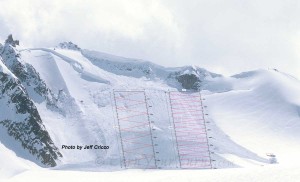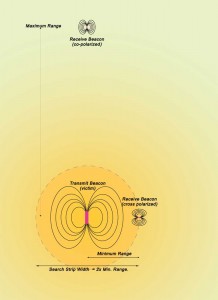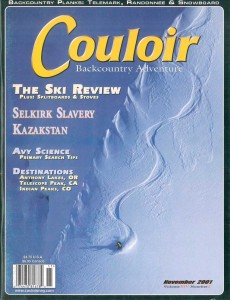One simple thing you can do in preparing for a real avalanche rescue is to figure out what the Search Strip Width of your avalanche transceiver is. This involves taking time to do a few iterations of measurements with you and your friends.
There are more complicated ways to determine search strip width that take into account things like the spatial orientation of the victims antenna combined with a probability factor. Though reliable this requires a lot of testing, something the average person simply will not do. It does yield a larger range, which can help to shorten a search. However, the simple way is more conservative and with modern (circa 2012) beacon technology, good enough:
Search Strip Width = 2 X Minimum Effective Range

Why Search Strip Width matters. The path on the left is half the distance covered by the path on the right, due to a larger SSW, saving time and improving the odds of a live rescue.
The Minimum Effective Range of a beacon is the distance between a transmit and receive beacon pair when they are cross polarized, i.e., the relative spatial orientations of their antennas are orthogonal, or at right angles (90°) to each other. The use of the word “effective” implies that both beacons are working reasonably well, that is, the batteries aren’t indicating less than 50% reserve power, or the beacon isn’t too cold to operate, etc. The Minimum Range could, in theory, be zero if the beacons aren’t in reasonable working order.
Determining Minimum Effective Range
- Set up your test in an open field (at least 100 yards square), preferably in a rural area without power lines, cell phone antennas, or nearby metal.
- Set a beacon to transmit with it’s antenna pointing straight up, perpendicular to the ground. You will want to use as many different models of transmit beacon as available to note differences (make it a party with your friends). It will also be worthwhile to alternate between fully charged and weak batteries to note the differences in range. Remember, you may not know if the victim’s beacon has fresh batteries or not.
- Starting from far away, turn on your receive beacon and hold it horizontally. Then walk towards the transmit beacon. Note where you first pick up the signal, but keep walking. The point here is not to just pick up a signal, however faint, but to have a reliable signal. And until the committees and professionals come up with a number, or methodology they agree upon, all I can do is give you some guidelines on where to make the call for what the Minimum Effective Range is.
- Finally, measure off the distance between the transmit and receive beacons. Your Search Strip Width is twice this range.
- Spend a few more minutes and get comfortable recognizing, or pacing off this distance so you can guesstimate it reliably.
- If you’re lazy and don’t get around to doing your own tests, my recommendation is to assume a minimum effective range of no more than 10 meters (33 feet).
| Mfg/Model | Min. Range | SSW |
| Arva Neo | 40 m | 80 m |
| BCA Tracker DTS | 15 m | 30 m |
| BCA Tracker 2 | 33 m | 66 m |
| Barryvox Pulse/Element | 38 m | 76 m |
| Ortovox 3+/S1 | 33 m | 66m |
| Pieps DTS/Tour | 40 m | 80 m |
| Pieps Freeride | 12 m | 24 m |
For our own in-house tests at Couloir I set the criteria for the minimum effective range to be the point where I received both audio and visual clues. That way there was some redundancy, and theoretically, more reliability in the signal detected. For analog beacons, that meant not only could I hear a signal, but at least one of the LED/LCD’s was blinking as well. For digital beacons, it meant that an audio pulse was heard, and the screen indicated distance and direction of the signal.
By using the two-clue criteria we noticed that all beacons had a very similar minimum effective range, somewhere in the neighborhood of 12-15 meters (circa 1999). As digital beacons have taken over the market, that minimum range has doubled for most brands and models, but not all. Pieps Freeride and the original Tracker DTS are the noteable exceptions. Most other beacons have a minimum range of at least 30 meters.
Because of the disparity in where the minimum effective range should be defined, I encourage you to do your own tests and err on the side of being conservative and reliable. That, as a matter of course, will necessitate finding a point somewhere inside the range where a signal is first picked up, even with cross-polarized signals.
This article was first published in Couloir magazine Vol. XIV-2, Nov. 2001. Appropriate revisions made to reflect technological improvements.
© 2013



1 pings
[…] Search Zig-zag your way down the slide path according to the Search Strip Width of your beacon. The idea here is to cover as much ground as fast as possible to get to your friend […]